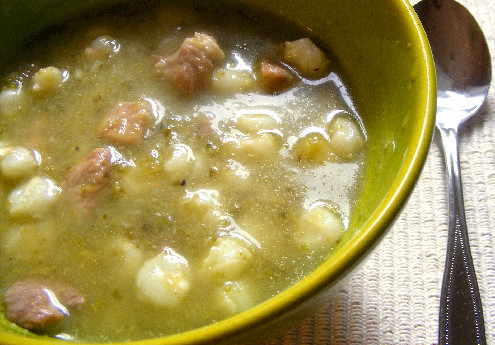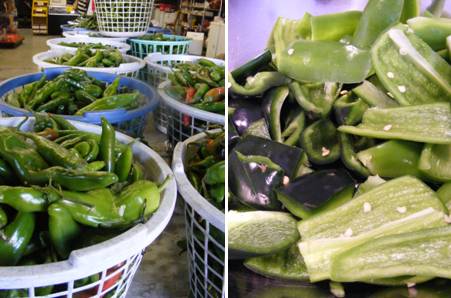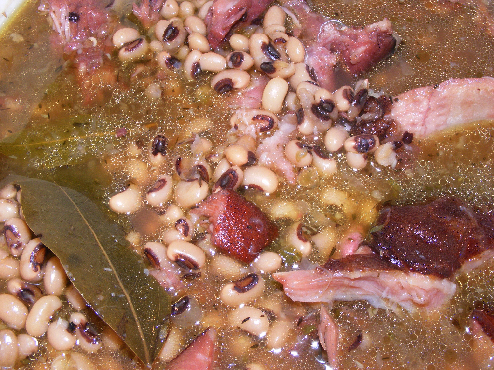
For the past several years, I’ve had cooking a good pot of pozole on my list of things to do. If you’ve never had it, you’re missing out. Pozole, also spelled posole or posolli, is a hearty Mexican soup that’s typically made with pork, hominy and chiles, and traditionally eaten around Christmas, although nowadays more regularly. It’s also believed to be a good hangover remedy.
Hangover or not, this soup is gooooodddd. Alone it’s luscious – spicy from the chiles, earthy from the hominy and rich from tender pieces of pork roast. Then when you sprinkle it with dried oregano, fresh lime juice, bits of onion, crispy cabbage and whatever else you flavor, it gets even better.
I’ve looked for inspiration while eating out but have been repeatedly disappointed because I had my heart and taste buds set on a green or clear pozole that was both light and satisfying – something resembling the version I had over 10 years ago with a friend from New Mexico. I prefer the green version over the red for two reasons: red pozole is almost like menudo (another Mexican soup with hominy) and a lot of folks get heavy handed with the red chile, which can get pungent.
So, when my girlfriend Chelby and her husband Don hooked me up with this green chile version, I knew I had to give it a go – the two know good grub (I think it’s a Texas thang) and Don’s version doesn’t have tripe (stomach lining), which I don’t mind eating on a rare occasion but will reserve for my menudo.
Green chiles are a staple ingredient in most Southwestern kitchens. And, early fall is prime time for folks to buy them by the bushel, fresh or roasted. Last week I got my loot: some Hatch, poblanos, and Anaheim – perfect for this recipe. Note, we’re using fresh, raw chiles for this soup.

Hatch chiles hail from Hatch, New Mexico, which has built a reputation as the Chile Capitol of the World among some. For this recipe, Don recommends Hatch chiles, which are more medium to hot on the Scoville Scale. If you can’t find them, substitute with poblano chiles, also called pasillas, which are typically milder. Poblanos are commonly used roasted and stuffed for popular dishes like chile rellenos.
Besides the chiles, the other star ingredient in this dish is hominy, called cacahuazintle in Nahuatl. It’s a natural variety of white corn with large kernels that is about four times the weight of regular corn kernels. Its taste is distinctive, earthy like that of corn in corn tortillas rather than the sweet flavor of corn in corn of the cob.
This recipe is easy to make, despite the length of this post. Enjoy! And, let me know if Don and I’ve converted any of you red pozole lovers.
Tidbits on Green Chile
- Green chile is generally a reference to its fresh state and red chiles refer to those that have dried. Generally, as chiles grow, they start off green and turn red or yellow.
- Chiles retain their heat level regardless of whether it is cooked, dried or frozen. When using fresh, to reduce the amount of heat, remove the seeds and veins. And, be sure to avoid touching your eyes and other sensitive areas after handling.
- “Hatch” chiles are not a variety of chile pepper, but rather a reference to where they are grown, according to the Chile Pepper Institute of the University of New Mexico.
(more…)
Print & If you liked this post, please share:




 Eating black eyed peas on New Year’s Day is a longtime custom among African Americans and Southerners who believe the legumes will bring prosperity and good luck, especially when paired with greens, which symbolize money. Some folks say you just need to eat a spoonful and others say at least 365 (one for each day of the year). Regardless, this year, in this economy, the superstitious dare not skip this tradition.
Eating black eyed peas on New Year’s Day is a longtime custom among African Americans and Southerners who believe the legumes will bring prosperity and good luck, especially when paired with greens, which symbolize money. Some folks say you just need to eat a spoonful and others say at least 365 (one for each day of the year). Regardless, this year, in this economy, the superstitious dare not skip this tradition.




